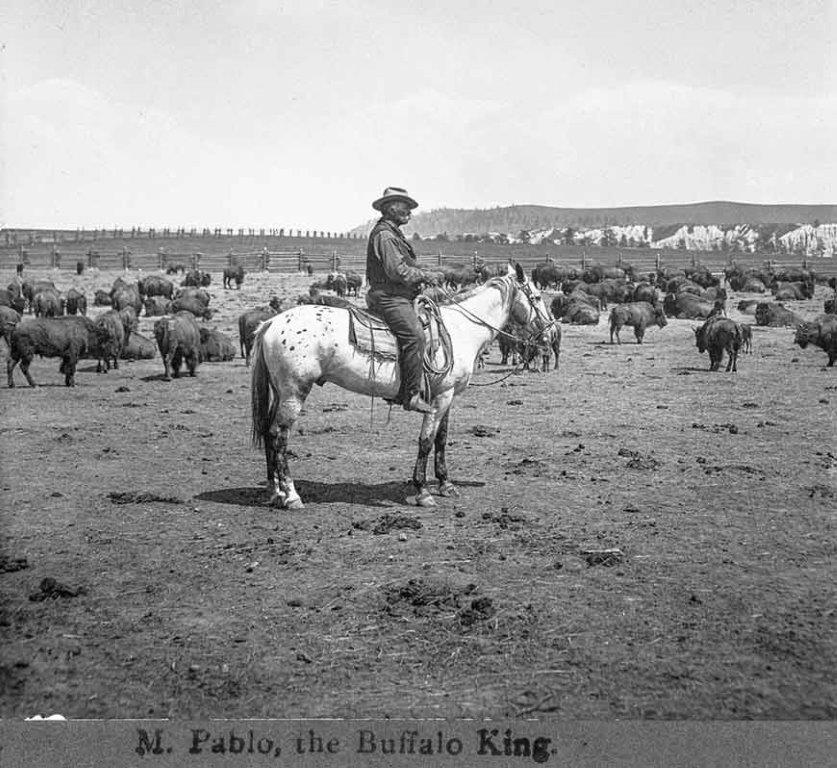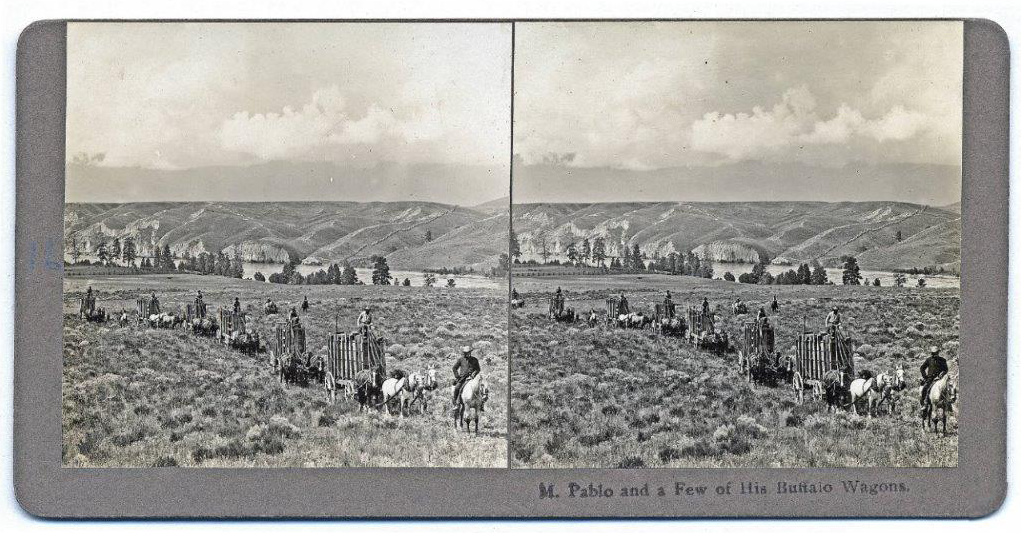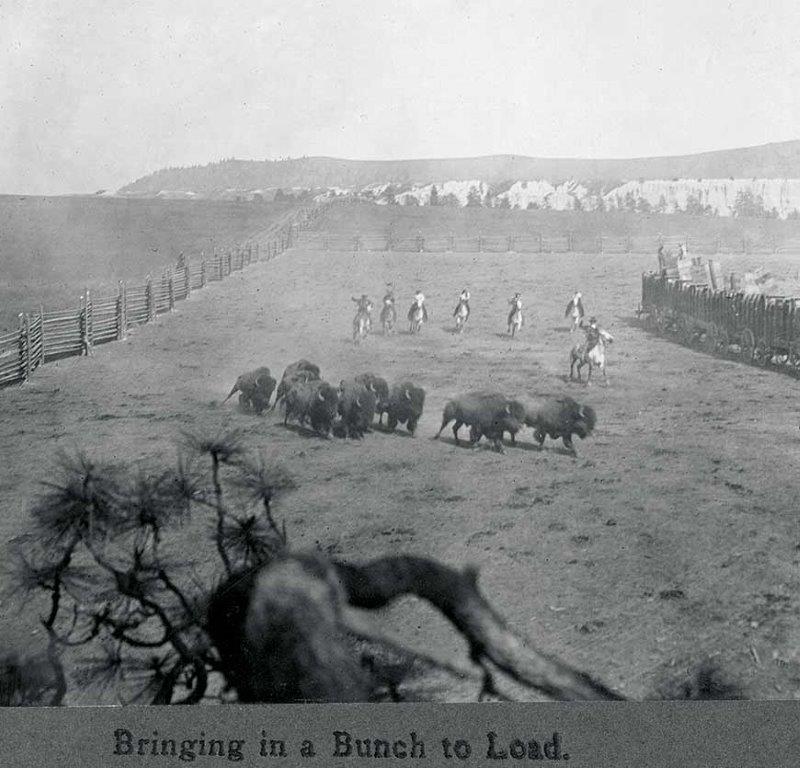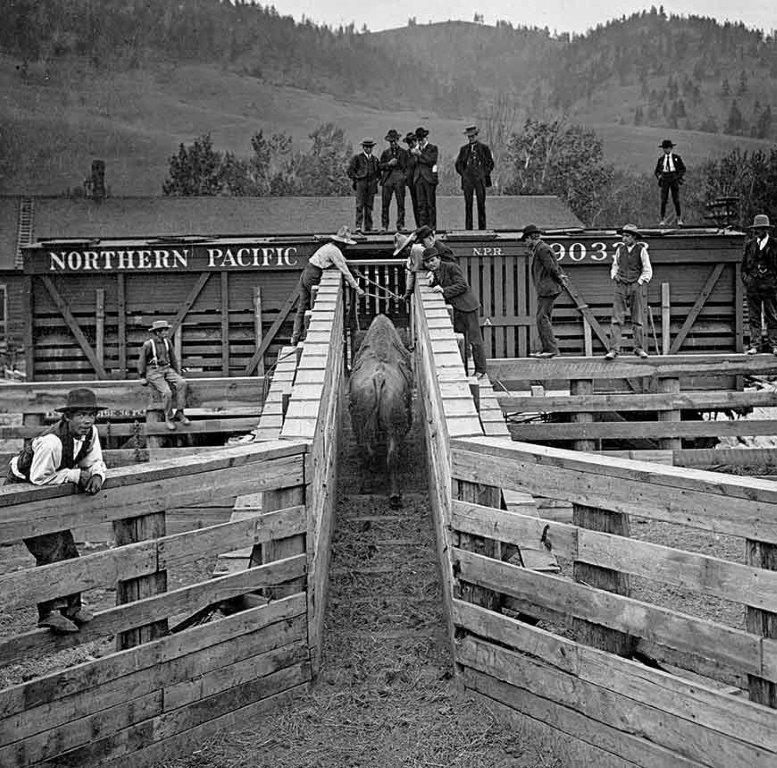They were wild, and did not take kindly to being chased to the railway station in Ravalli, Montana—or getting loaded into railway cars. Especially the renegade bulls.
Pablo’s buffalo—he thought there were somewhere between 300 and 700 head—were grazing in the Bitterroot Mountain Range and the Lolo National Forest along the Flathead River.
Turned out there were 716 buffalo and it took 6 years before they all reached their destination in Wainwright, Alberta, according to Valerius Guist, Canadian author of Buffalo Nation: History and Legend of the North American Bison.
The first twenty cowboys Pablo hired for the job only succeeded in bringing in a few buffalo at a time, trailing and hazing and running them the 30 to 50 miles to the railroad pens and loading at Ravalli.

Cowboy artist Charlie Russell joined the Pablo crew for roundups in spring 1908 and fall 1909. He called the cowboys “a wild looking bunch that looked good to me.” Michel Pablo is 5th from left in dark shirt and tipped hat. Courtesy Montana Historical Society, NA Forsyth, photographer1869-1949.
In a story captioned, “Loading the Allard buffalo for shipment to the North,” Montana’s Daily Missoulian explained the difficulties of Pablo’s first roundup, on May 29, 1907.
“To get a good idea of the difficulties that attend this work, take the most ornery range steer, multiply his meanness by 10, his stubbornness by 15, his strength by 40, his endurance by 50 and then add the products.
“You will then have some conception of the patience and skill that are required to load buffalo into a stock car,” challenged the news article.
For the second roundup in November that first fall, the Canadian press—waiting in the wings—had this to say:
“The drives . . . were as spectacular as anything ever seen on the range.
“The battle grounds were in the bad lands of Pend d’Oreille and in the foothills of the mountains, where every man took his life in his hands in the dare-devil dashes hither and thither, through cuts and ravines, over ridges and foothills or down the valleys honeycombed by the dry courses of the mountain torrents, in fast and furious pursuit of the bands of buffalo. . .”
“Sometimes the cowboys were the pursuers and sometimes they were pursued.
“In cases where their anxiety to turn an animal carried them closer to the buffalo than discretion should warrant, a vicious charge would result, and the rider would have to extend his horse to the limit to escape from the horns of the furious monster.”1

“The drives were as spectacular as anything ever seen on the range,” reported the Edmonton Bulletin, Nov. 8, 1907. “Every man took his life in his hands in the dare-devil dashes hither and thither, through cuts and ravines, over ridges and foothills.” Montana Historical Society, NA Forsyth.
Origins of Pablo’s buffalo herd
Pablo’s big, healthy, multiplying herd stemmed from the 6 buffalo calves that that Walking Coyote and his Blackfeet wife trailed west across the Continental Divide, through the most difficult trails of the Rocky Mountains that spring of 1873. When too tired to walk, some of the calves were carried on the backs of their pack horses.
For over ten years the small herd wandered the Flathead Reservation unmolested—the pride of the community, many said.
However, neighbors complained about the destruction they caused, breaking down fences, destroying gardens and crops.
When his friends, Michel Pablo and Charles Allard, offered to buy them for $2,000, Sam Walking Coyote decided to sell.
Ranchers in the Flathead valley, the two were of mixed blood. Pablo, the son of a Mexican cattle rancher and Piegan Blackfeet woman, born near Fort Benton, Montana, was married to a Native Pend d’Oreille woman, Agathe Finlely, at St. Ignatius Mission, according to Dave Carter, Executive Director of the American Bison Association.
Charles Allard, a neighbor and childhood friend, was born in Salem, Oregon. He had drifted onto the Flathead Reservation in Montana and married a woman of the Jocko Reservation.
The two men partnered to buy Sam Walking Coyote’s herd of 13 fairly-tame buffalo for $154 each in about 1884.
But Sam insisted—he would accept no personal checks. It had to be cash and to him, that meant $2,000 in gold.
Because of their Indian blood, the men and their wives had grazing rights on the Flathead Reservation. They could turn their buffalo herd loose on free range, as Walking Coyote had done.
Pleased with their purchase, they bought 26 more buffalo from Buffalo Jones of Kansas and their healthy herd grew rapidly until it exceeded 300 head.

The Pablo-Allard buffalo herd at home near the Flathead River 1884-1906. Montana Historical Society, NA Forsyth.
Pablo and Allard were generous in butchering a buffalo occasionally to share with neighbors, said Pablo’s son-in-law, Tony Barnaby.
He is quoted in an interview as saying that Pablo and Allard strongly believed that preserving the bison was their duty, privilege and pleasure.
“Pablo did not consider a buffalo as just a great shaggy beast of the plains,” said Barnaby.
“But rather symbolical of the real soul of the Indians’ past—something grand, that with the culture of his own race, had somehow managed to survive the undesirable features in the white man’s system.
“Often he would tell our Indians to butcher a fat buffalo. We all liked and respected Mr. Pablo and no Indian would steal any of his herd.”
Then—at the age of only 43—Allard died unexpectedly in 1896 of a knee injury that did not heal. His half of the herd, 150 head, went into his estate, and were sold, mostly in the area.
Pablo’s 150 head soon doubled again to 300.
Barnaby, described his father-in-law, as “lavishly generous to friend and foe—a lover of both races; fond of all animals.
“With a keen eye to his animals’ welfare, he knew at all times about where his buffaloes were grazing. He soon realized that they were increasing at a rapid rate: and after he returned from each daily ride on the range, he reported, ‘It is well.’”
Pablo learned in 1906 that the Flathead reservation was opening to homesteaders and he would lose his free range.
Buffalo purchase refused by Congress
Pablo immediately wrote forest service personnel asking if they could provide grazing land for his buffalo. But after much waiting for a reply, he gave up.
He then hurried to Washington and offered to sell his 300 buffalo to the U.S. government for $200 each.

View of Pablo’s buffalo on their home range in the Flathead valley. Spurned by US Congress. Montana Historical Society, NA Forsyth.
President Theodore Roosevelt approved the idea, as did Secretary of the Interior L.A. Hitchcock. But when they asked Congress to appropriate money, it was refused.
The US legislators in Congress said the price was too high. Some scoffed that the buffalo were not worth more than $15 each.
Many easterners agreed. The Indianapolis Star took an indignant stand against the purchase:
“Why Boston people should take an interest in the buffalo and why any intelligent persons should care for the preservation of these moth eaten, ungainly beasts, when their room might much better be taken up by modern blooded cattle, beautiful to look at, are conundrums no one answered.”
Barnaby said his father-in-law took the refusal hard, and described Pablo’s tears of disappointment at the news.
“When Pablo heard that our Congress could not be induced to appropriate a purchasing fund, he was moved to manly tears. He knew that free, open range was ending and that beloved herd must go,” said Barnaby.
Canada eager to purchase Plains Buffalo
Living not far from the Canadian border, Pablo then requested land from the Canadian government to graze his buffalo.
He knew Canadians were upset that all their Plains buffalo had been gone for years. Remaining in the far north were an estimated 200 or so of the elusive Wood Buffalo.
But the Plains Buffalo had vanished entirely from Canada, many slaughtered by the big semi-annual Metis hunts. Only the few Plains bison rescued by Tonka Jim McKay that were being exhibited at Banff National Park remained.
Pablo’s Canadian contact was a Metis man he knew, Canadian emigration agent Alex Alyotte, stationed in Great Falls, MT.
After some quick checking with his superiors, Alyotte found they were eager to buy buffalo. Rather than to provide pasture, they offered to buy his entire herd at his price.
He arranged a deal with Pablo that meant his entire buffalo herd could be preserved in Canada.
The Canadian deal was clinched in three months, when Mr. Douglas, Commissioner of Canadian Parks, offered to take the whole herd, an estimated 600 head, at $200 each, with $120,000 for the whole consignment.
Delighted, Pablo signed the final agreement, which included another $45 per animal for shipping to their new home near Wainwright, Alberta.
He closed the deal in March 1907.
After the deal was made, an embarrassed Congress was shamed by the press for insulting Pablo with their offer of $15 a head.
“We lost a chance at Bison, offered only $15 a head for Animals Worth $200!” accused a headline in the Harrisburg Telegraph, Pennsylvania.2
“Recently the Canadian Government, by a striking coup d’eta, secured the greatest herd of bison in captivity,” declared the Pennsylvania newspaper.
“And by returning them to an immense preserved tract in their native haunts on the plains of the great West have arrested natural extinction with such complete success that within a few years they anticipate possessing a huge herd of these animals.”
“The story of how this deal was consummated,” said a writer in the December Wide World Magazine, and how the United States lost a great opportunity of becoming possessed of one of the finest animal attractions in the world constitute an interesting romance.
“[Pablo] decided to offer the whole stock, just as it was, to the authorities, hurried to Washington and expressed his readiness to sell. The Government offered to relieve him of his stock at $15 per head. Pablo refused hotly and laughed out the parsimonious offer.”
Apparently, when it was too late, some Americans tried to change Pablo’s mind. But he stuck to his end of the bargain, and was praised for it by the Canadian buyers.
Tackling the Buffalo Round-up
Still, problems lay ahead. At first Pablo thought he might trail his buffalo all the way to their Canadian destination. But he quickly learned that his half-wild buffalo did not trail well, even for short distances.
Their eventual contract called for Pablo to deliver the buffalo to the railhead at Ravalli, Montana, where they could be loaded on railroad cars and shipped to Canadian destinations. The loaded railroad cars would need to be switched onto 5 separate railway lines to reach the Wainwright station in Sascatchewan.

These photos were taken by N.A. Forsyth during Pablo’s Montana roundup. The images are stereographs and produce a 3D effect when viewed through a stereograph reader. Round Up of the 2nd Herd of Pablo’s Buffalo. Montana Historical Society.
Pablo’s buffalo—he thought there were somewhere between 300 and 700 head—were grazing in the Bitterroot Range and the Lolo National Forest along the Flathead River.
The first twenty cowboys he hired only succeeded in bringing in a few buffalo at a time, trailing them the 30 to 50 miles to the railroad pens and loading at Ravalli.
Before bringing in any buffalo, Pablo supervised construction and reinforcement of stout loading facilities at Ravalli. He strengthened corrals, built wings to direct the buffalo toward the chutes, installed water troughs and fortified rail cars with extra timbers. He also had high wagons built to bring in especially difficult bulls.

Michael Pablo, the Buffalo King, riding through his buffalo corral at the railhead in Ravalli. His stout, high corral fence can be seen at center back. On the horizon to the left, the wings stretch away into the distance above the corral, serving to direct the animals in toward the gate. Montana Historical Society
Wagons with high sides were built especially to haul difficult buffalo into Ravalli, one at a time.
The wagons brought the worst outlaws into the corral from their range some 30 or 40 miles away, thus avoiding the difficulty of chasing stubborn bulls that long distance.

View of Michel Pablo on his horse trailed by six wagons loaded with buffalo in wooden crates during the round-up and shipping of his buffalo herd to Canada. Montans Historical Society, NA Forsyth.
Cowboy artist Charlie Russell joined the Pablo crew for spring 1908 and fall 1909 roundups (Zontek) and described Pablo’s cowboys thus:
“The riders were all breeds and [full bloods], a wild looking bunch that looked good to me,” Charlie Russell wrote in a letter to his friend Fiddleback.
In the accompanying watercolor, Charlie painted 9 riders galloping across the Montana prairie, long dark hair flying.
They wore braids, cowboy hats, feathers, vests, long-sleeve shirts and bandanas. They sported western rigs, riding quirts, with colorful saddle blankets and mounted on an assortment of horses.
Russell also wrote of one of their buffalo roundups:
“The first day they got 300 in the whings [wings] but they broke back an all the riders on earth couldent hold them. They only got in with about 120.
“I wish you could have seen them take the river. They hit the water on a ded run . . .
“We all went to bed that night sadisfide with 120 in the trap but woke up with one cow.
”The rest had climed the cliff an got away. The next day they onely got 6, an a snow storm struck us an the round-up was called off till next summer.” (The Buffalo Book, David A Dary.)
As he often did, Russell illustrated that letter–with a sketch of the wild buffalo taking the river.
In another letter, Charlie wrote,
“These bluffs wre nearly straight up and made a natural fence that would have held any cow on earth and from the looks I’d bet nothing without wings could have made the git away.
“But since I seen where they got out I wouldn’t bet what buffalo can’t do. They had 300 in the wings the first run but when they sighted the fence they split, running in all directions.
“And there ain’t no such thing as lieding a buffalo. He’l go through, under or over you, and a rider that runs in front of a buffalo is a green hand.” (Russell to Fiddleback, Jan 1909)
A New Plan and Pathetic Picture
An article in The Daily Missoulian written by F.L. Baghy explained the difficulties for the buffalo punchers, as well as the desperation of the buffalo and pathetic appearance of those captured.
“This spring it was decided to make no further attempt to drive the animals from Ronan to Ravailli, but to corral them, load them in crates mounted upon wheels and haul them over the mountains to the loading corrals. For this purpose heavy crates were constructed of heavy timber fastened together with steel and wire.

Roundup of some of the last of Pablo’s buffalo. Seven of Pablo’s buffalo wranglers bring in a bunch to load. At right is a convoy of the high wagons that were built especially to haul difficult buffalo into Ravalli, one at a time. Montana Historical Society.
“Through a loading chute the animals were driven into these crates, securely roped in and hauled by means of six and eight-horse teams over the long and dusty journey to Ravalli. Here they were turned out into a series of corrals from which they were driven, one at a time, into the loading chute.
“A noose around each buffalo’s neck and the tugging of a score of men landed the animal in his car, where the struggling beast was held until a partition to separate him from his companions could be firmly put into place.
“The dangers attending the work of handling the buffalo were many and there were numerous narrow escapes from death and injury on the part of riders and loaders.
“Fred Decker had his horse gored under him, and his brother Johnnie Decker, twice had his mount gored and was slightly injured, his life being saved only by the prompt action of Pablo and his brother in firing pistol bullets into the neck of an infuriated beast that was trying to kill man and horse.
“In their maddened struggles against being dragged into captivity 20 of the animals were killed, some of them rushing blindly against the sides of the corrals with such force as to break their necks. One, the patriarch of the herd, fought with a younger bull, then lay down in the loading chute and died.
“It was a pathetic picture to one who stopped to think, as he gazed at the lacerated, bleeding, ragged animals that stood in the corral at Ravalli, gazing longingly through the cracks of the high, strong fences out upon the hills, beyond which lay the wild free range from which they had been dragged in ignominious captivity to be loaded Into cramped stalls of railroad cars, there to be left to vent their fury in vain kicks against the walls of their prisons until steam and steel landed them at their new home.
“Slowness in hauling the bison from the round-up corral necessitated some of the animals standing in the cars for eight days before the last train started for Canada.
“At last all of the shipments save those that were killed and two that escaped were loaded, aboard and the long trip of 1,200 miles to the point of unloading was commenced.
“Canada has secured a bargain in buffalo and the United States has lost an asset which it may never be able to replace.”
Out of 10 bulls, only 3 loaded—4 died
Moving half-wild renegade buffalo bulls proved almost impossible. David Dary describes Pablo’s attempt one day to load ten full-grown bulls in boxcars, using three expert ropers on well trained horses.

Success: loading the last buffalo on the Northern Pacific at Ravalli.
Four of the bulls died from the furious exertion of their resistance during the day’s heat. Three grew sullen, lay down before they reached the rail cars and refused to budge, regardless of how hard they were pulled, pushed and prodded.
Of the ten bulls the cowboys succeeded in loading only three.
Some of Pablo’s outlaw buffalo, Charlie Russell wrote, avoided capture “without fear or respect for horse, man, rope or fence.
“If overtaken and roped, they threw the horse and his rider and went off with the rope.”
Pablo’s last seven buffalo—perhaps the wildest of all—were hauled to the railroad one at a time in special high-sided wagons built to hold one buffalo each.
Pablo planned to sponsor hunts by local people for the outlaw bulls that escaped the roundup.
But Montana’s Attorney General intervened by declaring them safe under Montana law. So instead, poachers took over and quickly dispatched every last one of them.
Next: Part II. Pablo’s Grand Buffalo Shipment to Canada

Francie M Berg
Author of the Buffalo Tales &Trails blog


